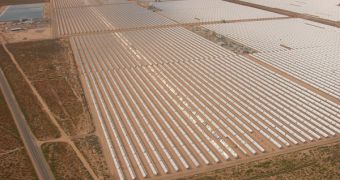Starting 2012, the U.S. military plans to begin construction of one of the largest solar-powered electrical plants in the country, which is to be finished and fully operational by 2014. The plant will generate an enormous 500 megawatts of energy, several hundred times more than the largest current such facility, that on Nellis Air Force Base, which outputs only 14 megawatts. The project aims at reducing the carbon emissions of the military power grid by more than 4 million tones over the next 25 years, with estimated savings at about $21 million.
The future plant will only be second to the one currently being constructed by OptiSolar, which, with its 550 megawatt electrical current generating capacity, will be the largest thin-film photovoltaic plant in the world. When connected to the grid, it will significantly decrease the army's electrical bill, which now stands at about $3 billion per year. The power plant will be constructed at Fort Irwin in California. Keith Eastin, the Army's assistant secretary for Installations & Environment, said "By making greater use of alternative and renewable energy, Army initiatives will bring energy savings and security to the Army, reducing the risk of power disruption."
Apparently, the military is also involved in several other energy-saving projects, each meant to reduce its dependency on fossil fuels. A brand-new 30 megawatt geo-thermal plant is to be constructed at Hawthorne Army Depot by 2012, in collaboration with the Navy. In addition, more than 4000 electric vehicles are to replace some 800 petroleum-powered ones, over a period of three years. With a span of three years, this plan aims at reducing the whooping 11 million gallons of fuel that military vehicles currently consume every year.
Environmentalists say that the Army's actions are commendable and that seeing a presumed-conservatory portion of the administration taking such a leap forward brings more hope of someday being able to implement the usage of alternative fuels on an even larger scale. The military, on the other hand, seems to have realized that its current fuel and energy consumption patterns are becoming more and more difficult to maintain, especially with the current economic crisis.

 14 DAY TRIAL //
14 DAY TRIAL //